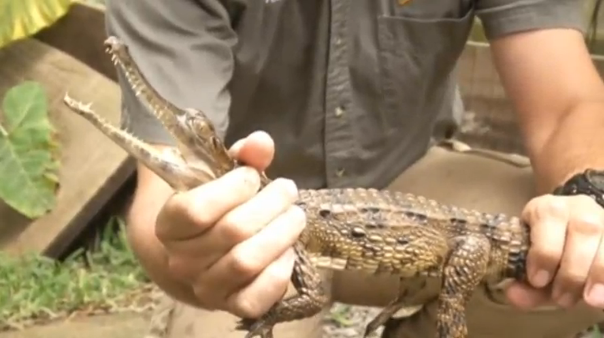
ABIDJAN, Ivory Coast (Reuters) — When conservationists discovered the world’s newest crocodile species after years of sloshing through mangroves and swamps from Senegal to Uganda, the elation was tempered by the knowledge that it was on a path to extinction.
Now, in its struggle to survive, the West African Slender-snouted Crocodile’s fate is tied to a zoo in the heart of Ivory Coast’s economic capital Abidjan, that itself faced an uncertain future not long ago.
“Essentially what we did, we kind of looked at some of the historic literature, and I don’t mean from 20 or 30 years ago, I mean from 150 years ago at what some of these very early British and French natural historians were recognizing about crocodiles across the landscape and what they were describing as unique species, based on what characters and why, and some of them made sense, or maybe made sense. Some of them didn’t. We kind of overlaid some of those hypotheses about species on the landscape, on the west and central African landscape and said okay, we’ve got a bunch of deserts here, we’ve got a mountain chain here, we’ve got habitat that’s totally inappropriate here, its never been appropriate for the past 20 thousand years. So what does that mean for those crocodile populations, ” said conservation biologist Matt Shirley, who discovered the West African Slender-snouted crocodile species.
In 2011, following a decade-long political crisis and a contentious presidential election, civil war broke out in Ivory Coast. Soon, gun battles were raging in the neighborhoods surrounding the Abidjan Zoo.
Tia Lama, who has worked there for nearly 25 years, was one of a handful of dedicated employees who braved the violence to feed and care for the animals.
“There was nothing to eat especially for the primates who like to eat papaya tree leaves. We had to go outside to get them food to eat. There were personnel who were stepping over dead bodies to go out looking for food. If we didn’t, what were the animals going to do? They didn’t ask to be here,” Lama said.
Today, the zoo is slowly recovering. New animals have been brought in.
Visitors, many of them school children, pour in through the arched entrance, leaving behind a chaotic city of 5 million to catch a glimpse of animals most will never see in the wild.
Some three dozen adult crocodiles lay stretched out in the dust or bobbed motionless in their newly upgraded pond at the zoo. They represent the largest captive population of West African Slender-snouted Crocodiles in the world.
“It makes it a very critical institute for the future of the species. It means that we have the potential to live the dream of this team in the eighties and re-implement captive breeding, take those babies and re-put them back in the wild for either re-stocking areas that have gone extinct or augmenting populations that are just hanging on by a thread. And Cote d’Ivoire in that respect is also one of the most important countries in the region as it has some fairly decent forest blocks, it has a decent network of protected areas, has some interesting community conservation areas that we are finding that we can actually work with the people and re-stock,” Shirley said.
The zoo also has a breeding program for the crocodiles and is receiving assistance from partner organisations in the United States.
And though a lack of easy access to specialized equipment has forced a certain amount of improvisation, including egg incubators built out of old Coca-Cola refrigerators, survival rates have been remarkably high.
So far, the breeding efforts have produced around 40 young crocodiles.
Some of them are now two years old, and Shirley is negotiating with the government to reintroduce them into the wild – first in Ivory Coast and then elsewhere in West Africa.
“Man’s survival depends on nature. If nature disappears, living beings will disappear too. So someone who protects nature is someone who protects human life and therefore I think that when you are in the heart of this nature conservation project, and the conservation of the environment, then you can only be happy,” said Barnabe Digbe, who heads the Abidjan Zoo’s crocodile department.
Today, no more than 1,500 West African Slender-snouted Crocodile are believed to exist in the wild, scattered across a territory extending from Gambia to Nigeria.








